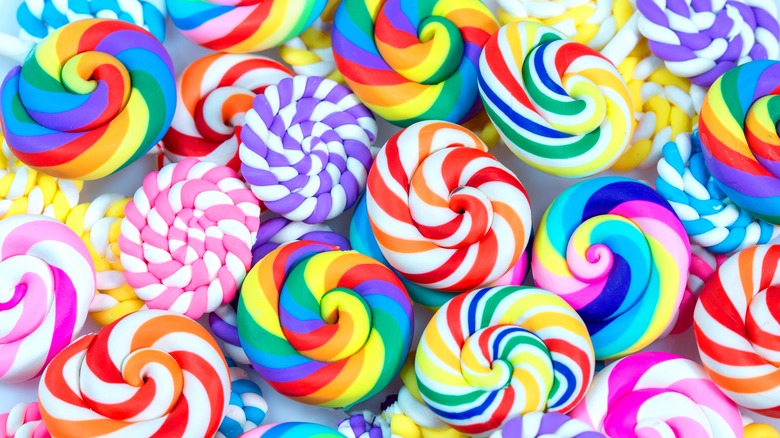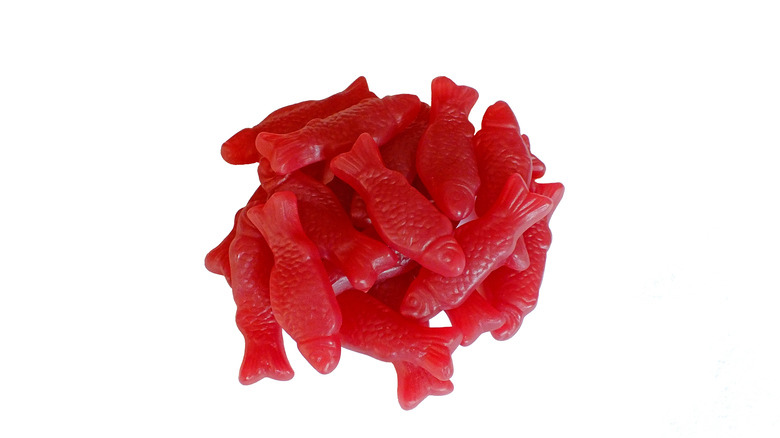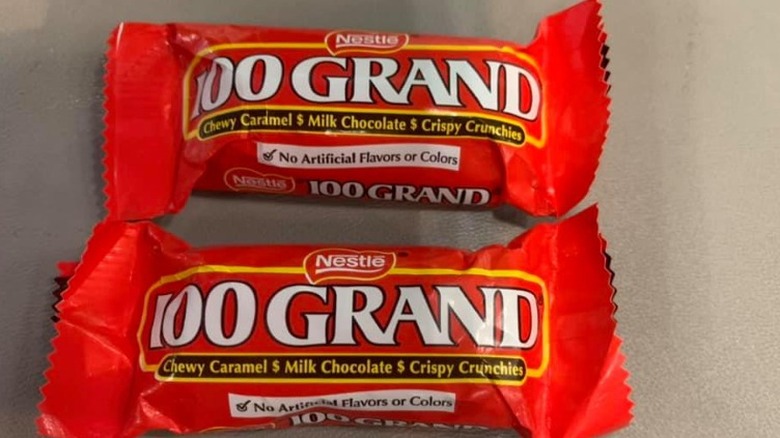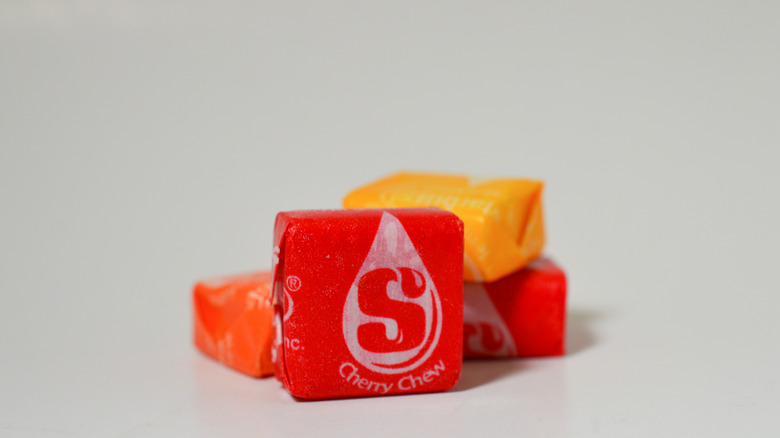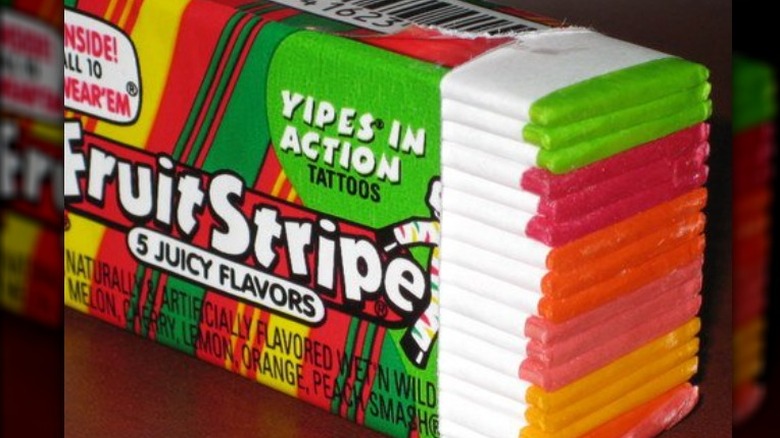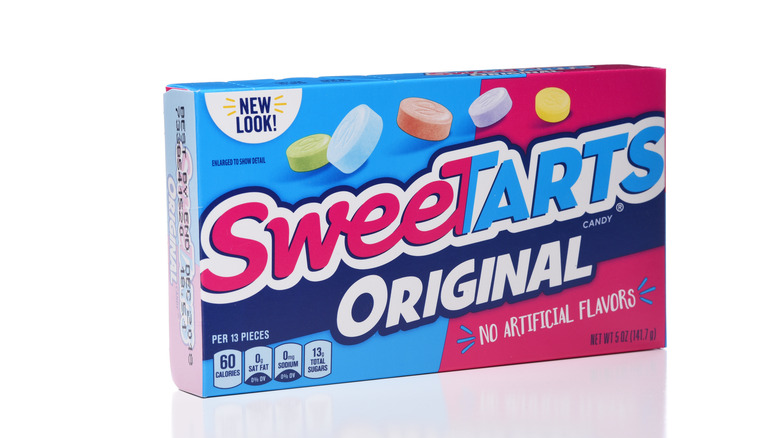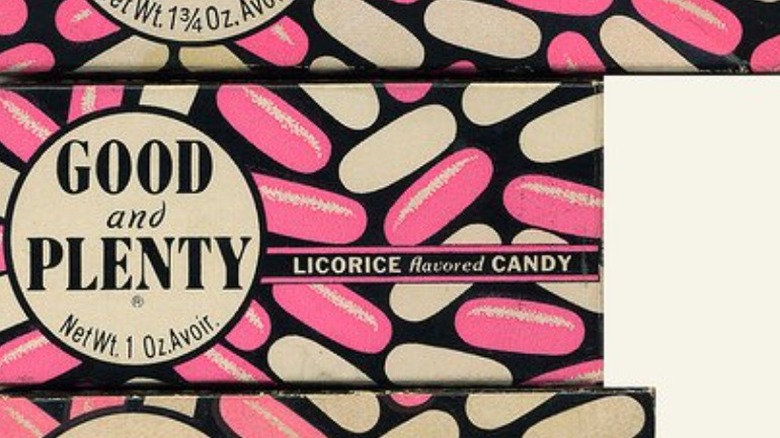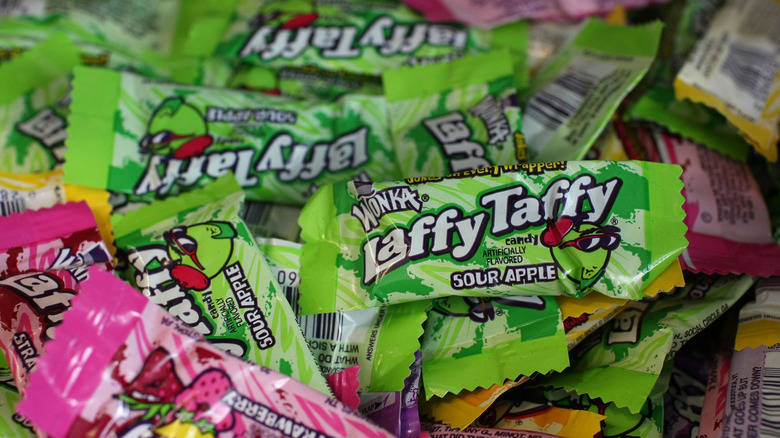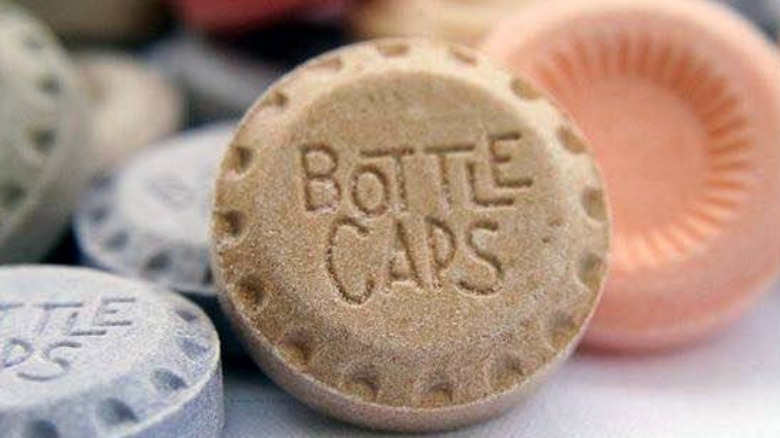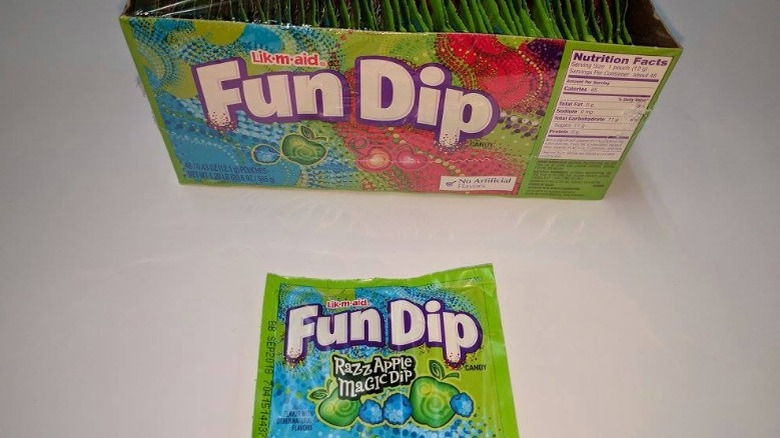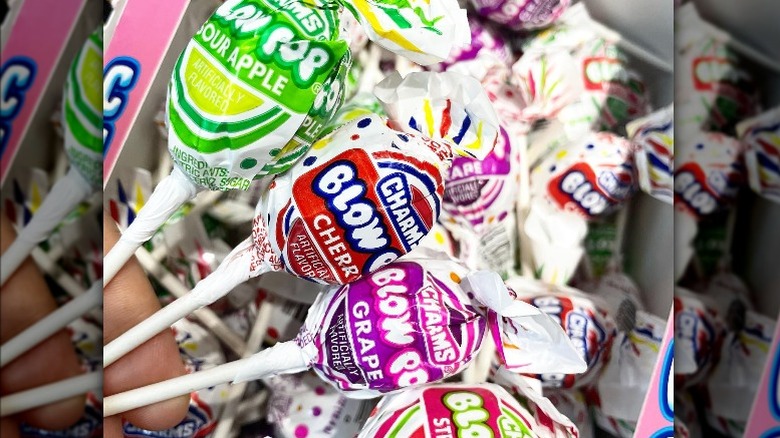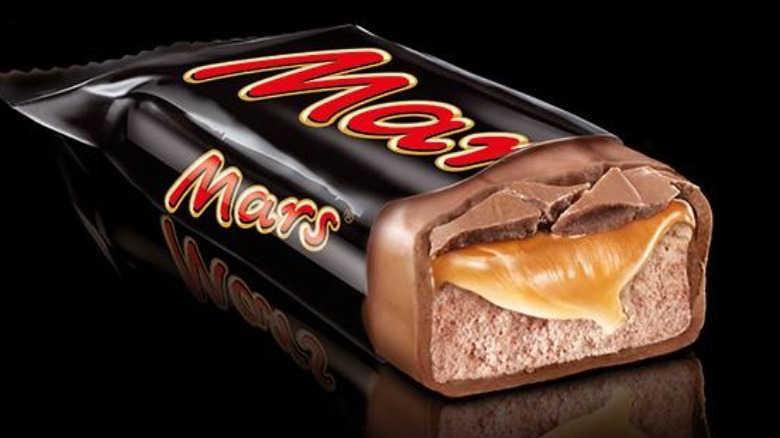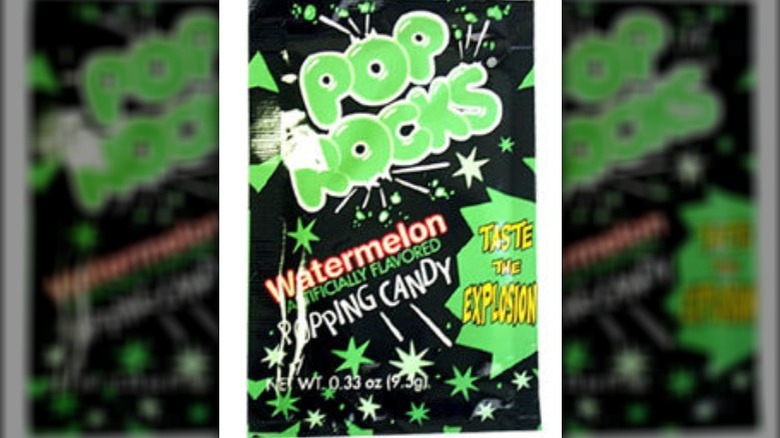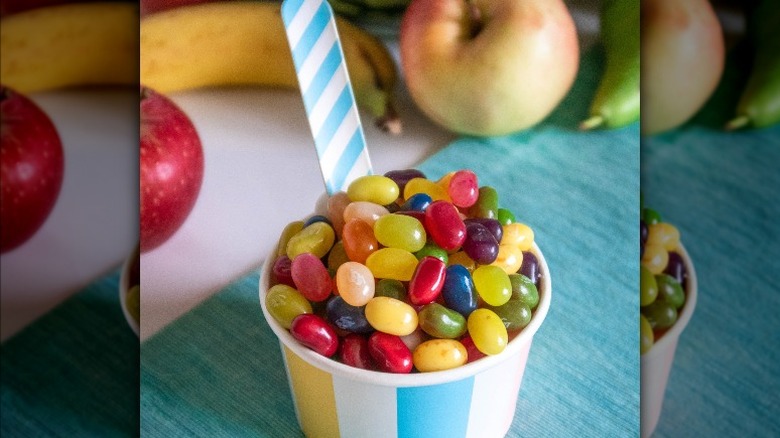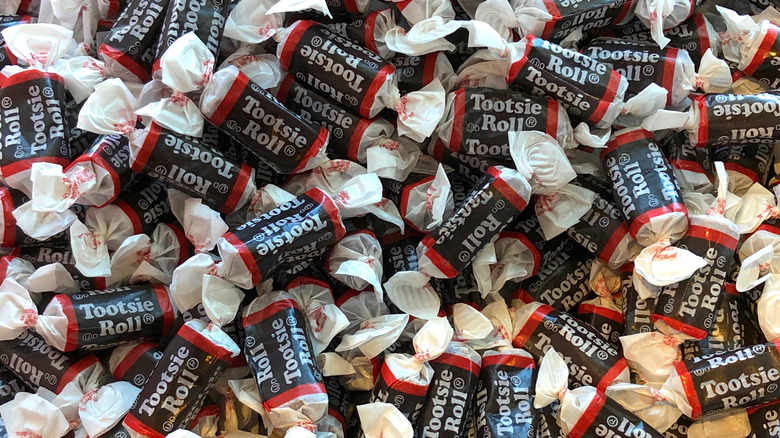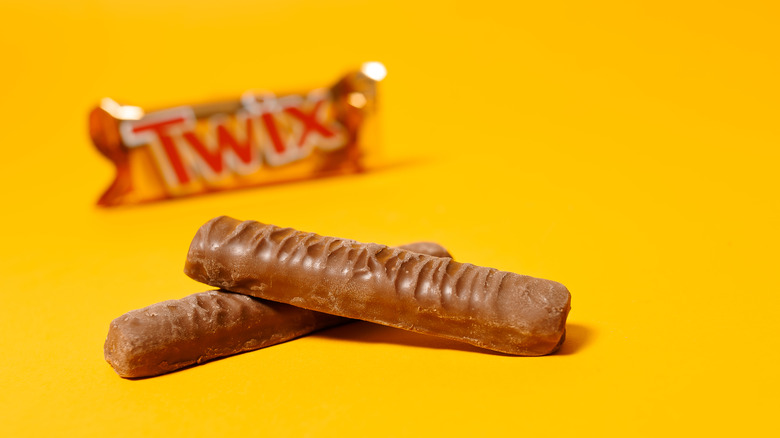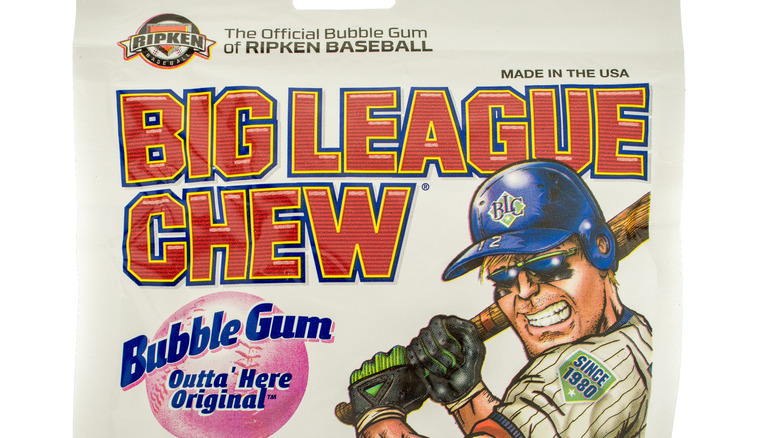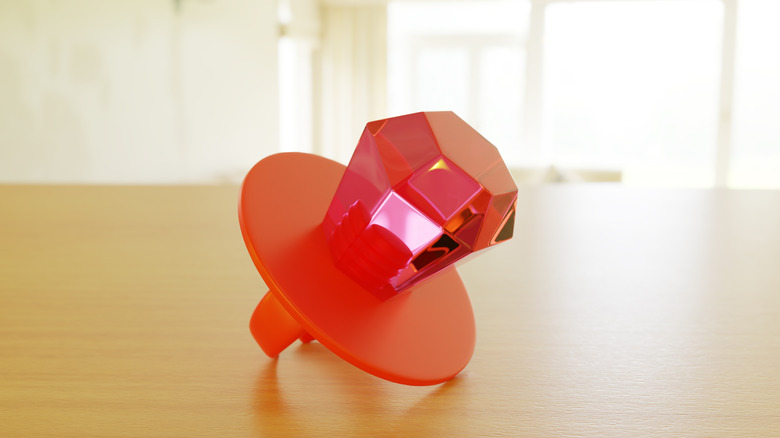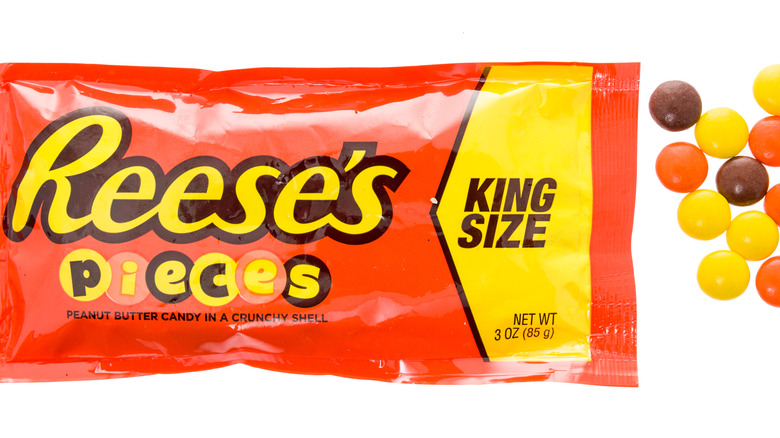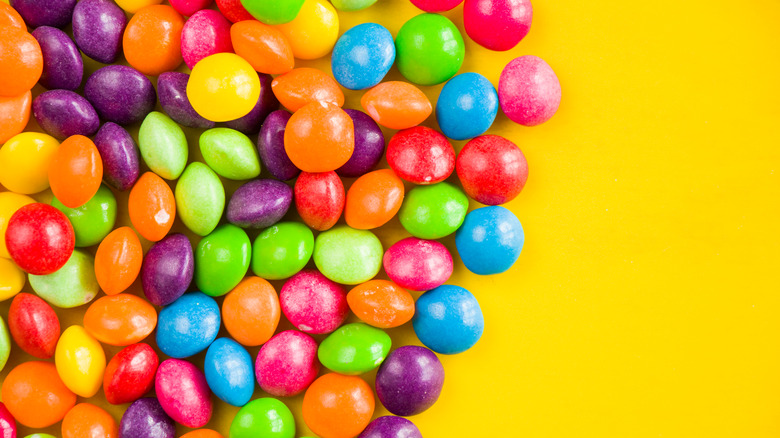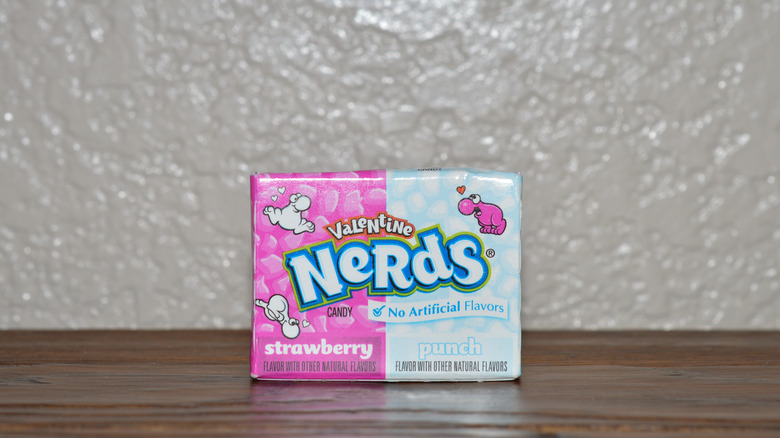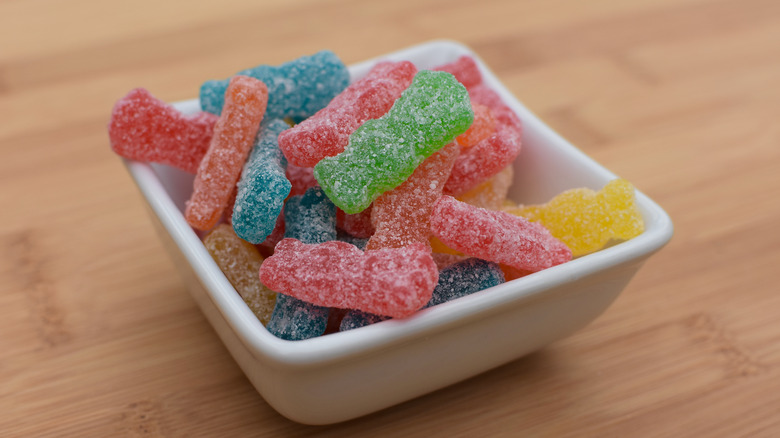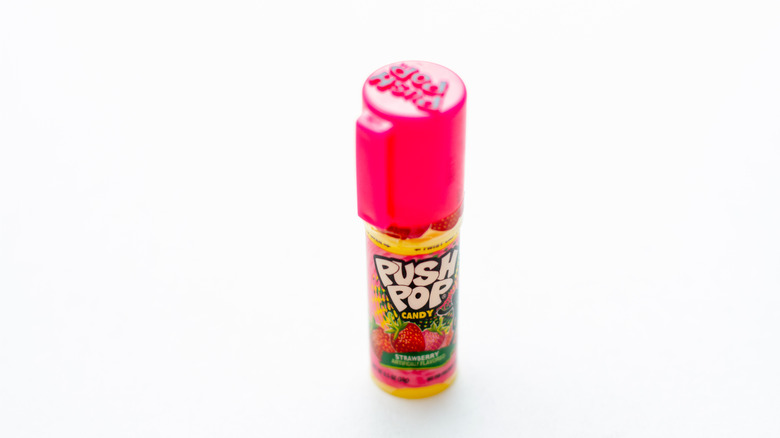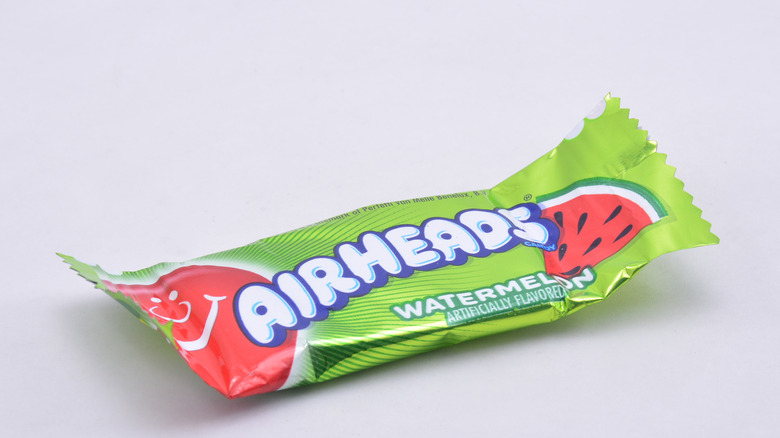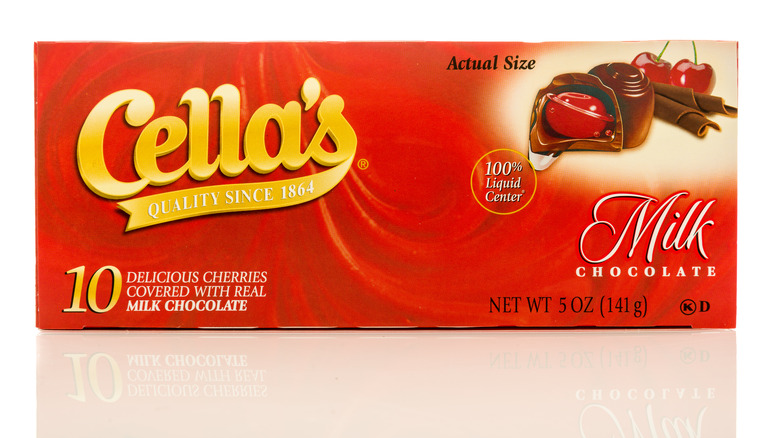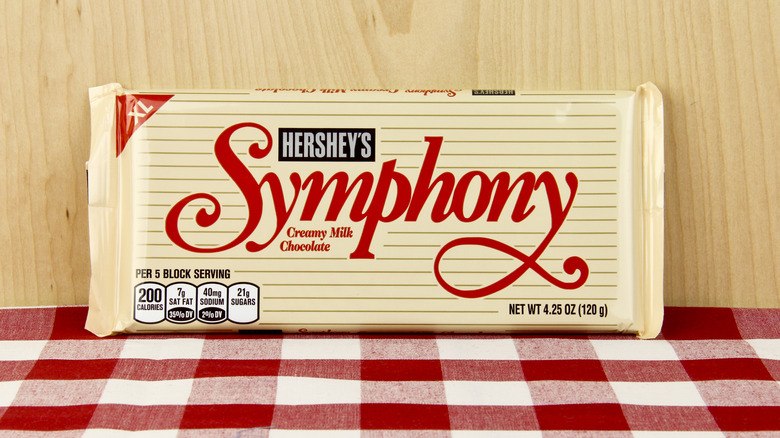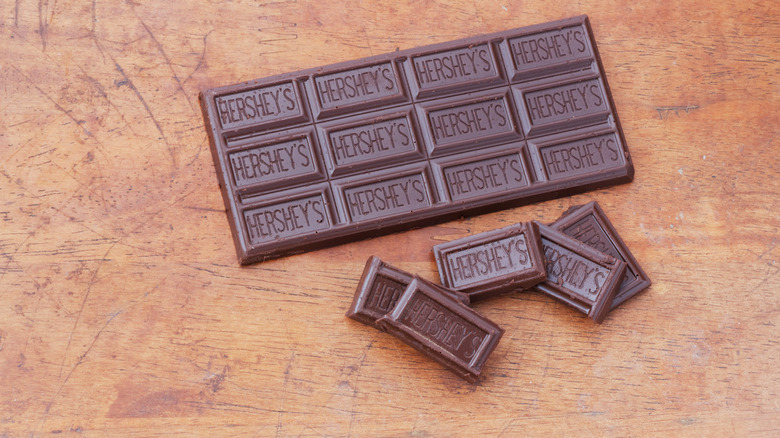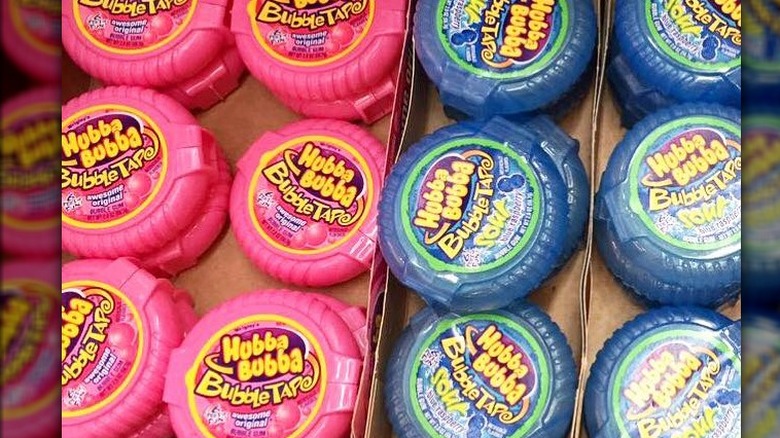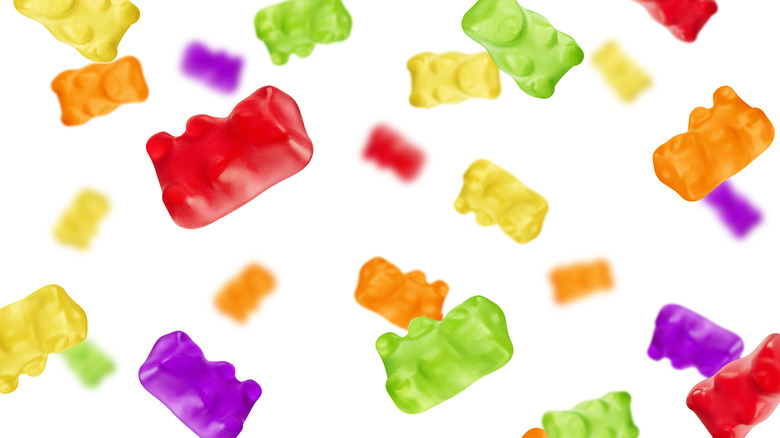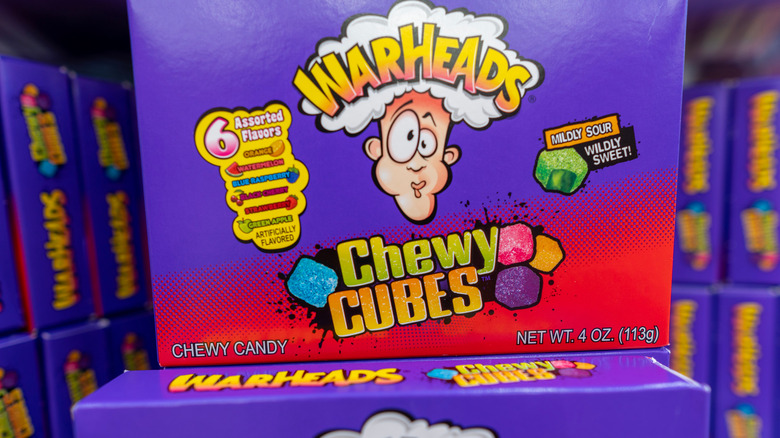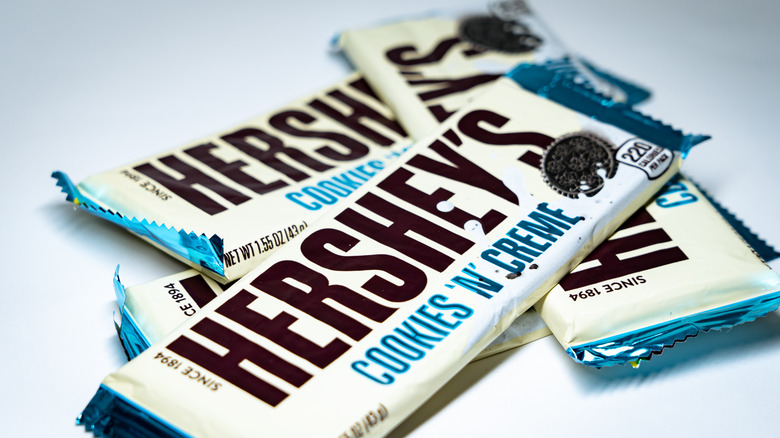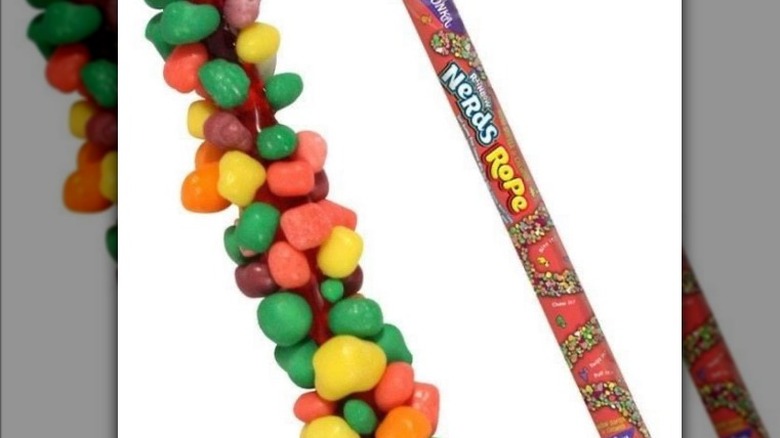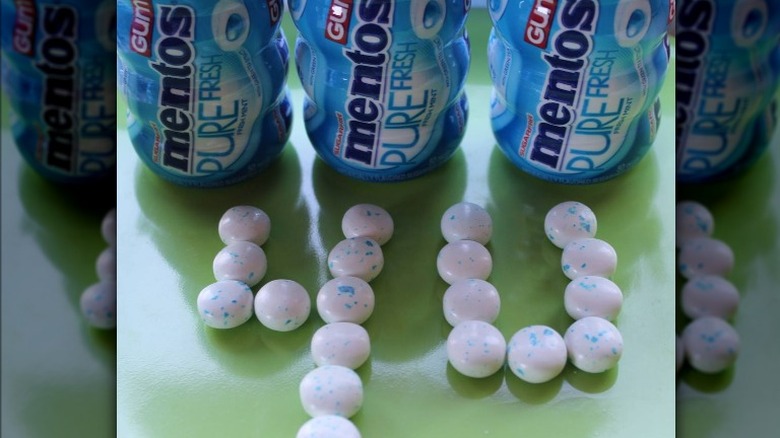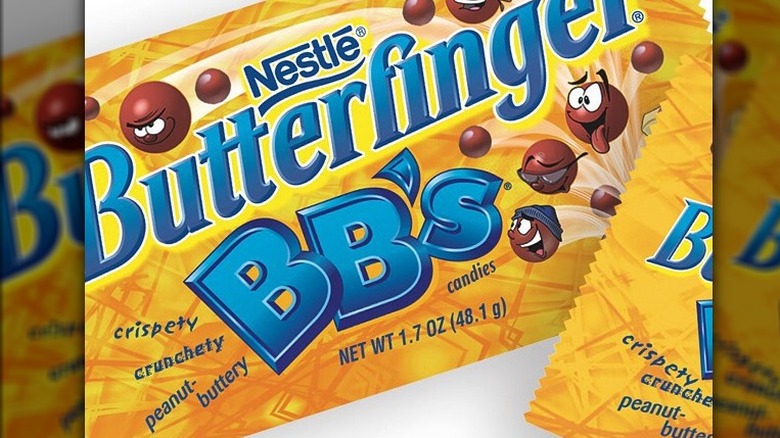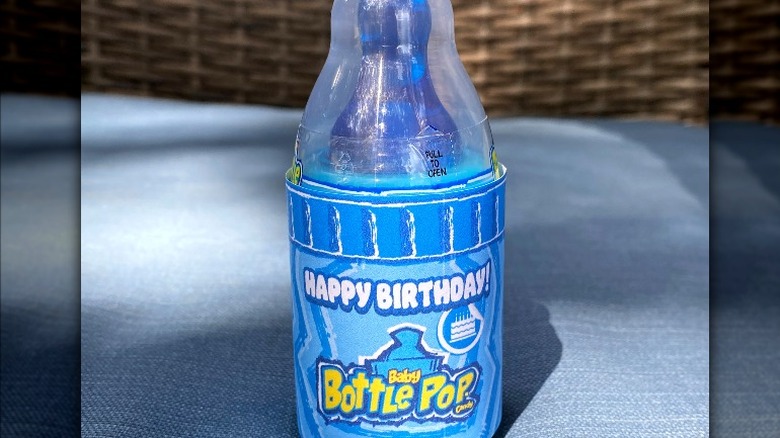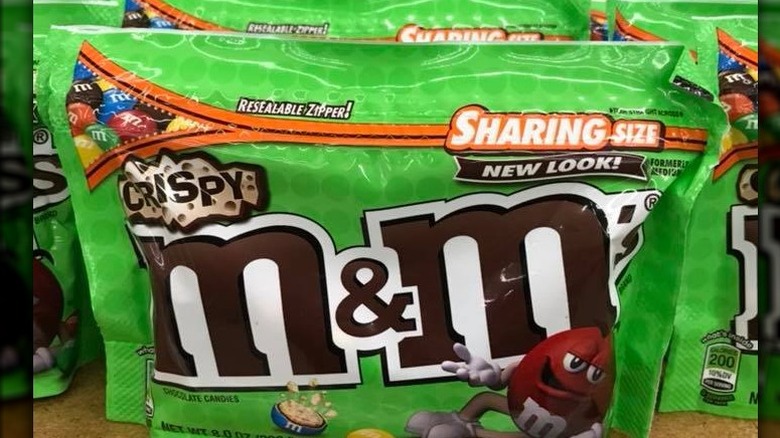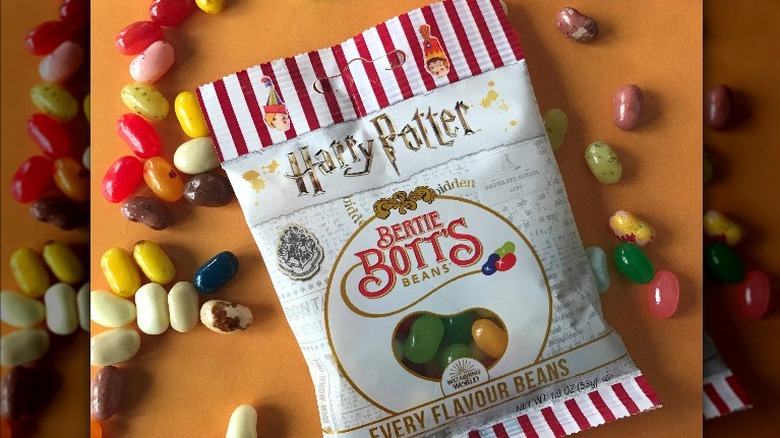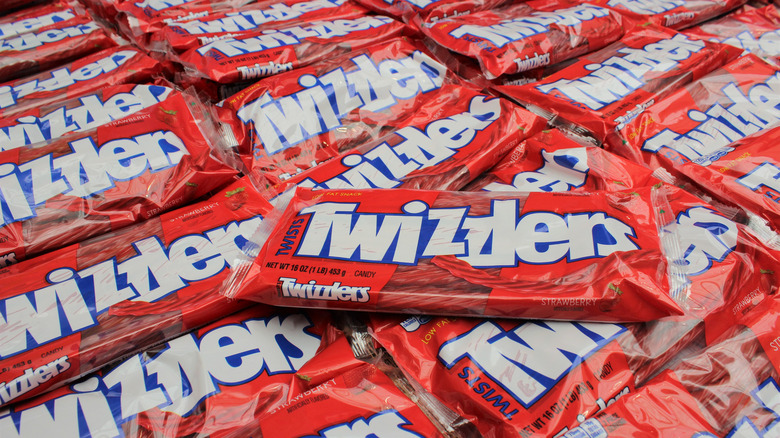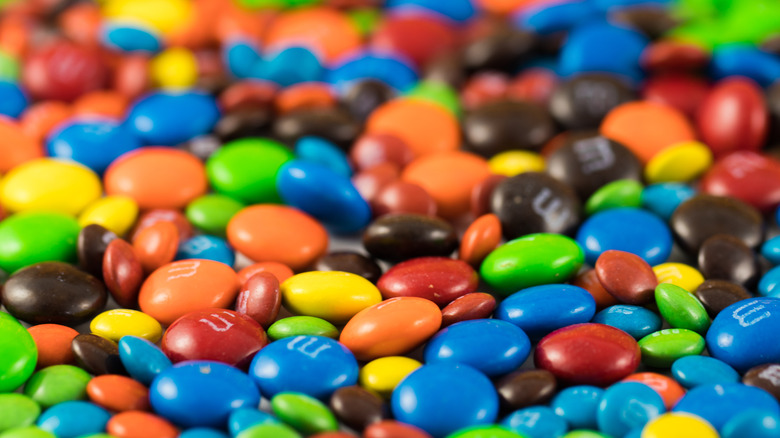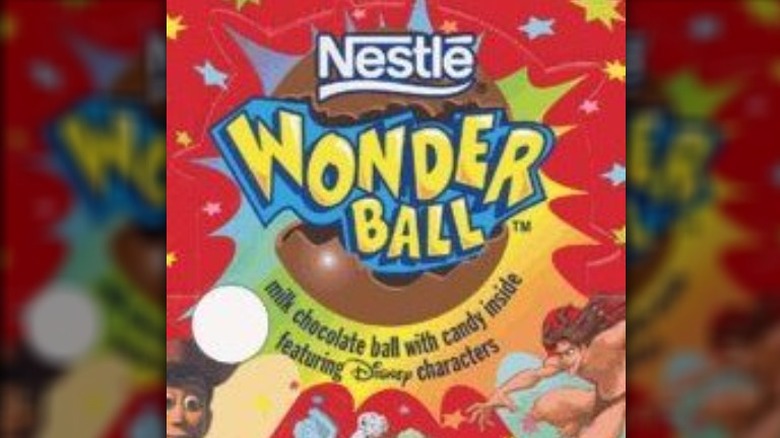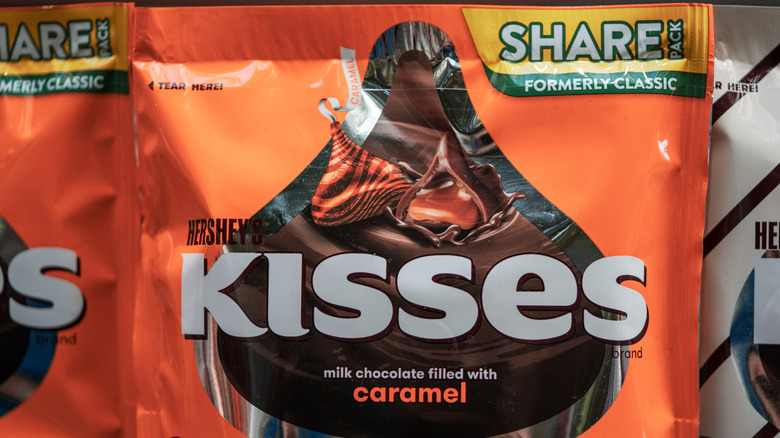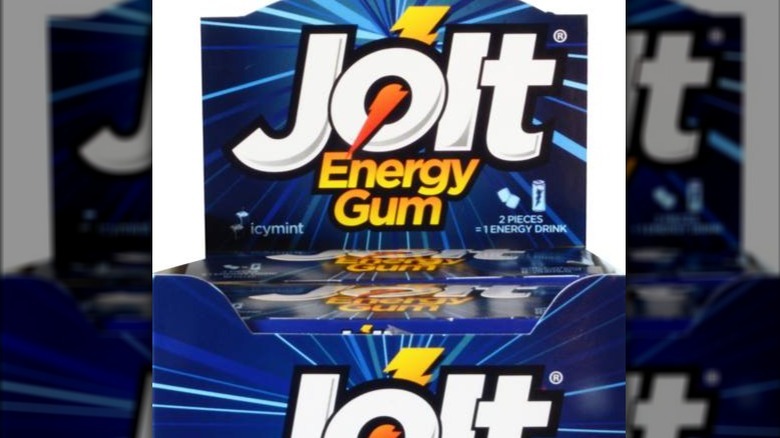The Most Popular Candy The Year You Were Born
The world is full of fantastic candy and confectionary treats. From conventional, rich, and delicious chocolate bars to brightly-hued candies bursting with fresh fruit flavors, there's no shortage of incredible offerings right at your fingertips. Over the decades, we've seen some of the most whimsical and creative candy concoctions hit the shelves. Some turned out to be long-lived, while others shone brightly and burned out quickly.
No matter what generation you're from — the swinging '60s, groovy '70s, too-cool '80s, neon '90s, or early aughts, there's a good chance that a particular candy hits you right in the nostalgia. Whether it's smooth, creamy, fruit-forward Starbursts or pucker-inducing piles of Warheads candies, childhood treats can take us right back to a time and place. So let's take a sweet trip down chocolate-coated memory lane with this rundown of the hottest candies and chocolates that caused a sensation the year you were born.
1965: Swedish Fish
Swedish Fish were the hottest crimson candy of the mid-1960s. According to Routes North, you couldn't visit a 7-Eleven or go to a movie without coming across a packet of Swedish Fish candies. As the name suggests, these iconic candies are Swedish in origin, but swam across the pond in the 1950s and made a big splash in the United States market. As Back Then History notes, while Swedish Fish have a fairly universally adored flavor, it's tough to pin down precisely what it is. Although ruby-hued candies are typically cherry, strawberry, or raspberry-flavored (via Slate), Swedish Fish might be lingonberry-flavored, Sweden's national fruit (via NICSwell) and a sweet nod to their origins.
Today, you can find a rainbow of different Swedish Fish, including tropical varieties, patriotic Swedish Fish, and multi-colored Swedish Fish Tails (via Routes North). They might even be swimming in your artisan cocktail (via Yahoo).
1966: 100,000 Bar
Classic 1960s-era advertising for the $100,000 Bar, now known as the 100 Grand Bar, champion it as a candy on the rise, holding its own with heavyweights like Nestle and Nestle's Crunch as one of Candy Marketer's 15th Annual Dime Bar Survey's Top Ten candy bars (via Collecting Candy). Today, $100,000 Bars might have changed their name and look and lost some of their clout, but these caramelly, crisp, richly chocolate treats were all the rage in the swinging '60s.
In addition to being delicious, $100,000 Bars and later 100 Grand Bars served an additional purpose as part of craft radio campaigns all across the country. According to MeTV Chicago, tricky DJs would often entice listeners with a promise of "one hundred grand," only to present the dumbfounded fans with a candy bar. Unfortunately, this stunt got Cumulus Media in trouble in 2005 when an irate listener sued the company for breach of contract (via CBS News).
1967: Starburst
Starburst candies are a Brit import that quickly caught on in the United States in the late 1960s. The treats first skipped across the Atlantic in 1967 as Opal Fruits, went through a brief period as M&M Fruit Chewies (via Paley Center), then became Starburst. Whether you call them Opal Fruits, Starburst, or M&M Fruit Chewies, the basic fruity premise of these snacks remains the same: pliable, taffy-like texture bursting with different luscious fruit flavors separated into bite-sized cubes with different color wrappings.
According to Snack History, the secret of Starburst's scrumptiousness lies in the ingredients, specifically fruit juice. Although the original, iconic, fruit-forward Starburst candies are still available today, you can also enjoy different variations on the theme. According to Delish, Starburst Minis hit the scene in 2013 in cinemas across the United States, proving that the perennial popularity of this soft fruit snack isn't going anywhere anytime soon.
1968: Fruit Stripe Gum
With its wacky and colorful zebra mascot launched in the 1960s, Fruit Stripe gum rapidly became a classic favorite thanks to its catchy marketing, multiple flavors, and intoxicating smell (via Old Time Candy). Way back in the day, Yipes Stripes came in five unique flavors, and each pack had 17 pieces of gum. As part of the Beech-Nut family, Yipes Stripes stood out in the crowded gum market thanks to its distinct design and decidedly kid-friendly flavor combinations, which became a huge hit.
Plus, gum-chewing kiddos got another treat with their pack of Fruit Stripe gum: a temporary tattoo. According to Pop Icon, sixties kiddos had the chance to get different tattoos in each pack, keeping gum sales up and little ones tatted up with stick-on art. Yipes Stripes is still around, and you can pick up a pack of childhood nostalgia online or at some select stores.
1969: SweeTARTS
According to Leaf TV, Sunline's SweeTARTS boomed in the 1960s thanks to an innovative marketing campaign that had the five-cent packs flying off the shelves. SweeTART mania is still going strong too, and its popularity hasn't waned much since the 1960s zenith (via Leaf TV). These candies are relatively nuanced for children's fare, balancing the expected sweetness of sugary discs with a sour punch. It originally came in fairly common fruit flavors like cherry and grape, although tropical punch was added a few decades later.
As with most candies, SweeTARTs packaging looks slightly different than it did during those heydays of the late 1960s, although the logo hasn't changed much. The double-colored logo features cursive and block font, likely as a nod to the sweet and sour mix inside. There are also other types of SweeTARTS for your snacking pleasure, like giant or mini ones and SweeTART chewies and gels.
1970: Good & Plenty
Talk to any '70s kid, and there's a great chance they'll wax poetic about one hard-shelled, colorful licorice candy: Good & Plenty (via In The 70s). These pink and white candies got a serious boost thanks to "Choo Choo Charlie" and a string of catchy commercials (via YouTube) promoting the brand. Eventually, Good & Plenty's joined other movie theater treats like Starburst and M&Ms to pair with hot buttered popcorn at the cinema.
Although these iconic and delicious pink and white treats have changed hands several times, most recently to Highlander (via Private Equity Professional), you can still get your hands on them pretty much anywhere. So grab a jumbo-sized box of these sweet, crunchy, chewy licorice treats and prepare to kick it right back to the '70s. Maybe even stream some old "Choo Choo Charlie" spots while you snack on this often overlooked but undeniably tasty treat.
1971: Laffy Taffy
Before there were dad jokes, there was Laffy Taffy, an early '70s treat best known for its gummy consistency and plethora of groan-worthy jokes (via Old Time Candy). According to the site, Laffy Taffy billed itself as Willy Wonka's preferred treat. The cheesy, rhyming name made Laffy Taffy instantly memorable, and the genius marketing campaign of crediting kids with the cheesy jokes made it collectible and coveted.
Not only would you get a different joke on each piece of Laffy Taffy, but the joke would be kid-approved. Most of the jokes were light-hearted, pun-heavy, and silly, although some did veer towards the grimmer side (which you wouldn't normally expect from a candy aimed at kids). Although Laffy Taffy might have been one of the first to pair jokes with candy, they are far from the last. Nassau Candy capitalized on the sweets and jokes combo for its Clever Candy just this year (via Confectionary News).
1972: Bottle Caps
With a classic, funky wrapper and tiny pastel discs of pure, fizzy joy inside, Bottle Caps candy debuted in the 1970s and have been going strong for 50 years (via Snack History). Although there have been some tweaks on the packaging and one flavor swap, these changes are relatively minor compared to what most candies go through. The original 1970s Bottle Caps used to have a lemon-lime candy, and newer iterations have cherry (via Candy Warehouse). Aside from the new labels and cherry caps, the original sweets are the same.
In addition to their traditional bottle cap shape, Bottle Caps have another thing going for them. They fizz away in your mouth, giving you that carbonated, sweet soda feeling in every disk. Plus, this vintage 1970s-era ad shows just how groovy the original art for these goodies was (via Flickr). It's no wonder '70's kids simply swooned for these sodalicious snacks.
1973: Fun Dip
Fun Dip is the hands-on '70s candy snack that evolved from Lik-m-Aid's Kool fruited powder and spoon combo (via Collecting Candy). Since Lik-m-Aid and Fun Dip both rely on fruity powder base as a significant candy component, you can speculate that they're all offshoots of Kool-Aid (via Food Beast), but the Fun Dip fad went a little bit deeper than that. Since Fun Dip came with a candy dipping stick, the experience was fully interactive. You could customize your ideal ratio of fruit dip to candy, making it a superior version of Lik-m-Aid, which didn't have a candy dipping wand.
Like Kool-Aid, Pixy Stix, or Lik-m-Aid before it, Fun Dip came in tons of different flavors, and '70s kids simply had to try them all. Fun Dip is still around, delighting a whole new generation of kiddos with its sticky, sour, and sweet combination of candy dipping stick and powdered fruit mix.
1974: Charms Blow Pops
A brand new decade ushered in a brand new spin on lollypops, specifically the dawn of the Charms Blow Pop. These lollies were everything by the middle of the decade, thanks to their crunchy candy shell and bubble gum tucked inside. As any '70s kid will tell you, the best part of a Charms Blow Pops was getting that last bite of exterior candy and mixing it with the bubble gum for tons of fruity taste. Charms Blow Pops are Charm's most popular product ever (via NJ.com), and still enjoy legendary success.
Charms Blow Pops originally came in classic flavors like strawberry, grape, and cherry, but have since expanded the pantheon to include newbies like blue raspberry, black cherry, and cherry ice (via Tootsie.com). According to the site, blue raspberry is currently the biggest-selling flavor, although we're sure that the originals are still going strong as well.
1975: Mars Bars
Although you might not see many Mars Bars around today, they made a splash in the states in the 1970s, even sparking a rivalry between U.S. and U.K. varieties. Cheeky websites like The Visible Mars Bar Project illustrates the difference between American and British renditions of these candy bars. Children of the '70s loved the original American Mars bar (via In the 70s). '70s Mars Bars were full of nougaty, chocolatey goodness and "an almond in every bite," according to advertisements from the time (via YouTube).
According to Snack History, the bar variations were born out of a desire to appeal to palates from either side of the pond. The American version is a bit sweeter with composite layers, and the British version has more distinguishable flavors. Whether Team Brit or Team 'Murica has the best-tasting Mars Bar is a rivalry for the ages, and ultimately, it comes down to your personal preferences.
1976: Pop Rocks
Pop Rocks are like a science experiment in your mouth, a candy that peaked in the 1970s and early part of the '80s after being introduced by General Foods in 1976 (via Christian Science Monitor). According to the site, these noisy little candy pebbles are on the cusp of coming back, despite all of the drama they had the first time around involving a supposed deadly soda and pop rock mixture and an unlucky boy named Mikey, the poster boy of Life cereal said to be willing to "try anything."
According to lore, Mikey mixed Pop Rocks with a can of soda, then promptly exploded. This urban legend was designed to scare '70s kids, but probably just made them think that Pop Rocks were that much cooler. William Mitchell, the inventor of Pop Rocks, was quick to dispel the rumor, explaining that Pop Rocks might cause burping, but not spontaneous combustion (via People).
1977: Jelly Belly
In 1976, David Klein dreamt up the idea for a brand new kind of jelly bean, and by the close of the decade, it was dominating the candy world (via Tampa Bay). Today, the word "Jelly Belly" is probably the first thing you think of when you imagine jelly beans. Klein started his jelly bean empire in Alhambra, California, debuting the still-popular Very Cherry, Root Beer, Grape, Lemon, and Green Apple. Of course, licorice was also on deck, but we don't have to talk about that one.
Jelly Belly's have stood the test of time, appearing on candy shelves from coast to coast and even in the presidential oval office, thanks to its intensely flavored inventive line of beans (via Old Time Candy). Today, you can get an expansive variety of different Jelly Belly jellybeans, including its line of Harry Potter-inspired Bertie Bott's Every Flavor Beans, featuring vomit-inducing flavors and tasty classics alike.
1978: Tootsie Rolls and Tootsie Pops
Tootsie Rolls and Tootsie Pops were both big in the 1970s, with a string of famous animated commercials from the late part of the decade. At their core, Tootsie Rolls are a tasty fusion of toffee and candy, with a sticky, chewy consistency that makes these bite-sized candies iconic. In fact, Tootsie Rolls are still pretty well-loved, especially at certain times of the year. According to CBS News, Tootsie Rolls are the most popular Halloween candy in Minnesota.
Not only were Tootsie Rolls giant during the 1970s, but their counterparts Tootsie Pops also had a moment. According to Click Americana Vintage & Retro Memories, famous television detective Kojak was often seen savoring a Tootsie Pop in a bid to get healthier and quit smoking. Clearly, Tootsie Rolls and Tootsie Pops painted an excellent and wholesome vision of Americana during the 1970s, and young viewers definitely ate it up.
1979: Twix
According to EHow, 1979 was the year Twix officially hopped across the Atlantic from the United Kingdom to the United States. Like other candies before it (namely, Starburst), it switched names upon arrival (via Snack History). What was once known as Raider Bars switched to Twix Bars, and the double-barred, chocolate-covered shortbread cookie snack with the thick ripple of caramel running down the center almost immediately warmed itself to American audiences.
One of the key reasons why people fell head over taste buds for Twix is because they perceived they were getting a two-for-one deal on their candy. Twix's popularity in the late 1970s subsequently spawned several other Twix-inspired creations, like Twix-studded commercially available ice cream (via EHow). However, in the early days, most of the focus was on Twix's triple threat of shortbread, chocolate, and caramel, with commercials lauding the "hidden cookie" in the candy bar (via YouTube).
1980: Big League Chew
According to CNN, chewing tobacco was the great American pastime for those who played the great American pastime, with tons of Major League baseball players indulging in the smokeless stuff. This not-so-fun fact wasn't lost on children of the early 1980s, who craved a way to be just like their heroes. Fortunately, Big League Chew was there to save the day, a shredded bubble gum rendition that bore just enough resemblance to chewing tobacco.
Rob Nelson dreamt up Big League Chew in 1979, and it caught on quickly after that, according to Esquire. This iconic pink "chew" is so stubbornly tied with baseball that you'll even find it in the National Baseball Hall of Fame and Museum. Although Big League Chew was early '80s kids' gum of choice because their heroes chewed the real stuff, kids today don't make the connection between big smokeless tobacco and shredded gum, according to Nelson (via Sports Business Journal).
1981: Ring Pops
Ring pops had everything going for them at the start of the 1980s. On the surface, they were a delicious candy treat that you could wear. But they were also a cute candy nod to the decade of decadence, the over-the-top '80s (via Express). Although these pops were technically invented in 1979, television made them household items in the 1980s thanks to a clever jingle and a little nod to marriage, just kid-friendly (via Candy Favorites).
With classic commercials (via YouTube) and the undeniable novelty that Ring Pop brought to the table, it's no wonder that this treat went full steam ahead into the 1990s. You can still find this so-called wearable candy online or at specialty candy stores, although it's not as ubiquitous as it once was. Still, if you want to be as glamourous as a ten-year-old circa 1981, definitely get your hands on some of this edible bling.
1982: Reeses Pieces
Reese's Pieces had a massive moment in 1982 thanks to blockbuster success featuring a young boy who befriends an alien. "E.T. the Extra-Terrestrial" dominated cinemas that year, becoming the year's undisputed box office smash (via New York Times), and the film featured the chocolate-covered, bright little peanut butter candies in one of its most moving scenes. According to Mistakes Were Made, M&M's passed up the opportunity to feature in the film, leaving room for Reese's Pieces to shine. In the now-classic science fiction film, the human boy Elliott befriends the shy alien by offering him Reese's Pieces, promptly jumpstarting sales of the candy in the real world.
Although there's plenty to love about the creamy peanut butter and chocolate bites that are Reese's Pieces, the candy will always be linked with '80s nostalgia and that pivotal scene in one of the decade's biggest movies. They were also the defining candy of the year that brought us that iconic phrase about phoning home.
1983: Skittles
Fast on the heels of other fruit-flavored candy creations like Starburst and sharing the same British roots (via Old Time Candy), Skittles arrived in North America at the end of the 1970s. By the early 1980s, Skittles were made domestically, and eventually, Wrigley took over the brand. What made these colorful candies so intensely popular in the early 1980s was a clever marketing campaign inviting Americans to "taste the rainbow" (via YouTube).
With a crispy candy shell, mega-bright colors, and a soft, chewy interior, Skittles hit the taste trifecta, giving Americans bite-sized treats in bold, different flavors. Although Skittles has changed over the years, they still make a point to listen to their fans and bring back long-lost and still-cherished flavors. According to Today, lime Skittles recently re-emerged in the pack after a nearly decade-long hiatus. Lime replaced green apple as one of the five rainbow flavors in the package.
1984: Nerds
If you were an '80s kid, there's a good chance that you remember Nerds. Kids got not one but two flavors of tiny, misshapen candies in each box of Nerds, making it fun to mix and match or simply dump the whole side of the box down your throat. According to Everything 80s Podcast, Nerds debuted in 1983, and these funnily-named candy darlings of the decade rapidly became very popular.
There are a few reasons why this might have been the case. First, the name is hilarious and slightly irreverent, and it would have made '80s kids giggle a bit at the grocery store or candy shop. There was also the duality of Nerds. The double-sided box made it seem like you got more for your buck than you actually did. You could also savor your Nerds piece by piece or wolf them down in one go. Whatever the draw, these lovable little candy wads made the 1980s all the more thrilling for candy-loving kids.
1985: Sour Patch Kids
According to Candy Favorites, Sour Patch Kids went through a re-branding of sorts and became one of the decade's top candies. Sour Patch Kids first started as extraterrestrials and ended as, well, kids. The reason for this space-age to downright ordinary re-vamp was simple. According to Delish, Cabbage Patch dolls caught on like mad during the 1980s, prompting Sour Patch Kids to change direction, ditch their space-age theme, and grasp onto the coattails of the craze.
In fact, Cabbage Patch dolls were so popular that there were even so-called "Cabbage Patch riots" in 1983 (via Timeline). So eat your heart out, Tickle Me Elmo! Sour Patch Kids might be an edible blatant rip-off of the bobble-headed Cabbage Patch Kids, but their last-minute game switch worked. They quickly became a favorite candy for '80s children, featuring sweet and sour renditions of fruity flavors like raspberry, lemon, orange, and lime in tiny, bite-sized "kids."
1986: Push Pops
According to Food Network, Push Pops' innovative packaging made them an instantaneous '80s classic, and a retro candy that any '80s babies will fondly remember. Launched in 1986, Push Pops came in plenty of different colors and flavors, and while hard pieces of fruit-saturated candy weren't new to the market, the design was. Each Push Pop came in a handy little, sticky-finger-free tube that you could eat at your leisure. Thanks to a click-on cap, Push Pops always stayed fresh with all of that gooey candy goodness inside the tube. Kids loved them, and parents probably loved them even more.
On Old Time Candy, people reminisce about their favorite '80s candies, and Push Pops often pop up (pun intended). These jewel-toned sticks of pure sugar made them ideal stocking stuffers, weekend treats, or suckable and savable summertime candies. Push Pops were in a true league of their own, even in an era when candy reigned supreme.
1987: Airheads
According to Candy Funhouse, Airheads candy is the brainchild of Perfetti Van Melle and has been wildly popular since it debuted in 1986. Although it's originally Dutch, Airheads is now manufactured in the southern United States, and combines two favorite American candy mash-ups: taffy and fruit. So whether '80s kids were getting them sour or sweet, they were picking up Airheads in droves.
Airheads quickly rose to candy infamy thanks to their catchy name and unique taffy and fruit combination. They are currently one of the top non-chocolate candies in the United States (via Candy Favorites). Airheads are still going strong, and you can find brightly-colored packages in every corner of all 50 states. Almost like more sugary versions of Froot Roll-Ups, Airheads are easy to eat and highly portable, a favorite treat for kids and adults who want to tap into that childhood joy of breaking open a fresh package of the good stuff.
1988: Cella's Chocolate Covered Cherries
Although chocolate-covered cherries have been around for several decades, Cella's Chocolate Covered Cherries had a lovely renaissance in the 1980s when the brand was scooped up by candy giant Tootsie, and boxes of Cella's Chocolate Covered Cherries started appearing on store shelves everywhere (via Zippia). Billed by Tootsie as "the premium chocolate-covered cherries," these decadent treats with a liquid center and juicy cherry inside quickly became a treat for both kids and adults (via Tootsie).
With creamy milk chocolate and decadent dark chocolate options, Cella's Chocolate Covered Cherries were an everyday treat, but were always particularly popular around the holidays when they featured gift boxes for the entire family to enjoy. Although Cella's Chocolate Covered Cherries aren't as popular as they once were, you probably won't find an '80s kid who doesn't remember the singular joy of biting into one of these fruity, chocolatey, sugary gems.
1989: Hershey Symphony
Hershey's tapped into its sophisticated side at the close of the 1980s by rolling out a candy bar that was equal parts chocolate goodness and clever packaging. According to Hersheyland, these beautiful bars were five years in the making, and the rollout included two unique bars. One Symphony bar was premium milk chocolate with a luxe texture that defied its drug store status. The second was studded with plenty of toffee and almonds.
The name itself was meant to evoke a classic symphony, playing with the idea that the flavors mimicked the melodious tunes of fine orchestral music. It was a classy play — and it worked, thanks to a robust advertising campaign from 1989 featuring Hershey Symphony bars as the stars (via YouTube). While plenty of candies went for a more whimsical and kid-friendly approach, Hershey Symphony bars went in the opposite direction, and the gutsy and unconventional approach certainly paid off.
1990: Classic Hershey Bars
While Hershey's Symphony bars might have been the breakout stars of 1989, classic Hershey's bars got a breath of life at the beginning of the 1990s thanks to a very unconventional reason: war. According to AP News, Hershey bars were the treat of choice for soldiers in the first Gulf War. Hershey sent Desert Storm troops 144,000 special "desert bars" designed to hold up in the sweltering heat. This mimicked a similar campaign where the Hershey Company helped out allied troops during the Second World War (via History) and gave a patriotic boost to the humble chocolate candy.
According to CNBC, traditional Hershey chocolate bars are still one of the most popular treats in the United States by a long shot. So perhaps it's a lesson that you don't mess with perfection, or that there's nothing better for morale — and company sales — than a big old bar of standard Hershey's chocolate.
1991: Bubble Tape
Bubble Tape is one of the most easily recognizable and unique '90s offerings, appearing in cylindrical cases with oodles of gum spiraled inside. According to Racket Magazine, Bubble Tape was the treat of choice for teens, making it notable because many top candies were popular strictly with the younger set. Perhaps it was Bubble Tape's snarky advertising campaign (via YouTube) or the fact that it could second as a hockey puck between classes. Whatever Bubble Tape's allure was, it was everywhere in the last decade of the 20th Century.
Some previous Bubble Tape enthusiasts credit the candy's can as one of the selling points, because it looked a lot like a tin of chewing tobacco. Empty Bubble Tape cans could easily be filled with Big League Chew, an '80s throwback, and carried around for easy consumption (via Racket Magazine). While the flavor was there, Bubble Tape's sass-to-spare certainly catapulted it to mega status during its heyday.
1992: Gummies
In 1991, Disney Channel broadcast Gummi Bears in its coveted afternoon block, capitalizing on a trend that had been brewing for some time and exploded in the early part of the decade. Gummi Bears, which was about tiny magic bears going on adventures and fighting big bads, was a massive hit with a catchy theme song (via YouTube). Cartoons aside, the early 1990s were gold for everything gummy. Gummies showed up in sushi and Lego form, and adults could slurp them down as supplements (via the New York Times).
It's easy to see why gummies were so popular in the 1990s: They were simply fun, and it was cute and cheeky to eat them in strange forms. Gummies started appearing in lunchboxes with Shark Bites as a classic nod to the humble gelatin candy. The epic gummie fad of the early 1990s certainly dredges up some nostalgia and a little pain when you realize that you can't get most of these treats anymore.
1993: Warheads
According to Children of the Nineties, Warheads defined the over-the-top era with their super sour, almost unpleasant taste that made you pucker on the first slurp. Although Warheads are a classic American treat, they were first dreamt up in Taiwan nearly 25 years before hitting the States. When they arrived in the early part of the decade, '90s kids went bananas for them (via Snack History).
Warheads were the type of candy that dared you to savor them until the last sliver. With super-sour flavors and an almost acidic taste, sucking on Warheads without shedding a tear was a way for '90s kids to prove their toughness. Unlike other tamer candies, you didn't eat Warheads to enjoy the sumptuous fruit flavor of mild lemon-lime or cherry; you ate them to show off. Even long after its debut, Warhead's allure still lies in its otherworldly sourness, with commercials daring viewers to "show their sour face" (via YouTube).
1994: Hersheys Cookies & Creme
According to the Candy Encyclopedia, Hershey's rolled out Hershey's Cookies 'n Creme bars in 1994 — snowy-colored bars with plenty of crushed cookies inside. It was Hershey's homage to Oreos, with far more cream filling than cookie base, and came in original and king-sized. Like regular Hershey bars, each slab of Hershey's Cookies 'n Cream had twelve tiny little stamped Hershey bars on it, keeping with the company motif but adding a whole new spin on things.
Hershey's Cookies 'n Creme bars were a hot novelty item in the mid-1990s, with a slick advertising campaign (via YouTube) touting the classic combination of cookies and white chocolate. The bars spawned other favorites, like Hershey's Cookies 'n Creme Drops and Hershey's Cookies 'n Creme Crunchers with the same basic motif: creamy white chocolate studded with plenty of crumbly chocolate cookie pieces. It was a refreshing, fun change from the company's rich chocolate bars.
1995: Nerds Rope
In a cute throwback to a couple of years before, Nerds evolved and rolled out Nerds Rope, a chewy, fruity licorice based studded with tons of tiny colorful nerds. According to PopSugar, Nerds Rope was the perfect candy for 90's kids with plenty of textural interest and tons of sweetness. The Nerds Candy website indicates that there "aren't even words" for the sugar-laden joy brought on by biting into a Nerds Rope, and children of the '90s were inclined to agree. It was getting two treats in one, all wrapped up in a portable package.
You can still get commercially-produced Nerds Rope or even DIY your own (via YouTube) if you have the patience and supplies. More than just a convenient snack, Nerds Rope is a big old bite of nostalgia, and a way for adults to fondly remember how they got to experience their favorite candy two ways during their lifetimes.
1996: Mentos
According to People, the ads that made Mentos a powerhouse candy in the mid-1990s were also a double-edged sword for Liam Killeen, the ad creator. Mentos' notoriously cheesy ad campaigns ran all throughout the decade, making the humble mint one of its breakout stars. However, although the ads were catchy and fun, they were also widely mocked. In the end, Mentos was the one laughing all the way to the bank, with sales tripling throughout the '90s due partly to its memorable ad campaign (via People).
Thanks to its ridiculous and often-polarizing commercials, Mentos even got some free advertising, appearing on late-night television and in blockbuster movies like "Clueless." As a 1996 ad illustrates, Mentos billed itself as the get-out-of-jail-free card for any awkward social situation (via YouTube). While having fresh breath might not get you out of a parking ticket or help patch things up with your spouse, enough Americans bought into Mentos lore to make this candy a '90s sensation.
1997: Butterfinger BBs
Although Butterfinger BBs are sadly no more, they were once the messy, chocolate-covered, spherical snack of hordes of '90s kids. Rolled out in 1992 but popular throughout the entire decade, Butterfinger BB's success hinged on a classic candy combination and some super slick advertising featuring legendary cartoon characters. Anyone who grew up in the 1990s can't hear the phrase "nobody better lay a finger on my Butterfinger...BBs" without immediately thinking of Bart Simpson and the clever television campaign that promoted this tiny snack (via YouTube).
Messy but glorious, Butterfinger BBs were orbs of pure peanut butter and crunchy chocolate joy. You could eat them by the handful or savor each single BB one by one, unless it was a hot summer day. If you were dealing with a heat wave, BBs tended to melt together into a squishy, chocolate mess, which might have been one of the reasons for their demise.
1998: Baby Bottle Pops
According to Snack History, Topps created Baby Bottle Pops in 1998 and immediately won the hearts of '90s kids all over the country. Like Fun Dip before them, Baby Bottle Pops were highly interactive. And like Push Pops, they offered a mess-free solution for enjoying your candy over an extended period of time. With clever packaging and a slew of different flavors, Baby Bottle Pops had all of the makings of a late '90s sensation, and they certainly didn't disappoint.
Commercials for Baby Bottle Pops featured a catchy tune and instructed kids to shake their Baby Bottle Tops before unscrewing them for pure, sugary fun (via YouTube). Listen at your own risk: The jingle has a way of worming into your head and sticking around for hours. Baby Bottle Tops were a fun, quirky way to close out the 20th century, and children of the '90s no doubt remember them very fondly.
1999: Crispy M&Ms
While traditional M&Ms had one layer of crisp atop a creamy chocolate center, Crispy M&Ms took it a step further by providing extra crunch in the form of ultra-crispy, milk chocolate candies with familiar branding. Commercials for Crispy M&Ms featured the orange M&M lamenting how tasty he was while sitting next to a turkey (via YouTube), and the new spin on classic M&Ms caught everyone's attention at the close of the decade.
Crispy M&Ms still have so much of a following that M&M brought them back (via NY Daily News). According to the report, M&M enthusiasts were begging the company to re-release Crispy M&Ms on an almost daily basis. While the original Crispy M&Ms had a relatively short run until 2005, they managed to touch on the nostalgia nerve in adult Millennials, some of whom got their Crispy M&M fix overseas when it wasn't available in the States.
2000: Bertie Bott's Every Flavour Beans
Although Jelly Belly first debuted in the 1970s, 2000 was the year that Harry Potter rocked the pop culture, entertainment, and candy universes and ushered in an era of Pottermania that wouldn't subside for decades (via Vox), and Jelly Belly's Bertie Bott's Every Flavour Beans were there to transport mere muggles into the uncharted reaches of the wizarding world.
According to Jelly Belly, Bertie Bott's Every Flavour Beans were a different kind of jelly bean medley, with a dastardly mix of delectable and disgusting flavors. You had to guess which one was which, and children of the new millennium loved guessing whether they were reaching for a booger or a blueberry bean.
With flavors like earwax, dirt, rotten egg, and soap floating around in the mix, cracking open a bag of Bertie Bott's Every Flavour Beans was like gingerly stepping onto a landmine, but kids ate it up — figuratively and literally.
2001: Twizzlers
Twizzlers had a brief mega-resurgence during the early aughts, thanks to a whimsical advertising campaign that asked viewers to make wacky shapes and animals out of their beloved Twizzlers (via YouTube). According to Big Valley Tiger News, these sensational spots made the strawberry-flavored twists the hot new thing, especially one of the most famous ones featuring a man making walrus tusks out of Twizzlers while running around the zoo.
Twizzlers certainly proved that silly sells, and although they had a spike in 2001, they remain ever relevant and popular today. According to YouGov America, over 90% of people have heard of Twizzlers, and more than 60% like the sweet licorice ropes. Furthermore, only 15% of the respondents said they didn't enjoy Twizzlers, so perhaps a snazzy marketing campaign mixed with an already-popular product proved to be enough to make Twizzlers super cool again at the beginning of this century.
2002: M&Ms
It's true that M&M's missed their chance for big-time blockbuster stardom when they turned down a poignant cameo in "E.T. the Extraterrestrial," but that didn't mean that the candy giant had already played its last card. In the early 2000s, M&M's made headlines by letting fans decide which new hue they should add to their pantheon of colors, and people jumped at the chance (via CNN). According to the report, a whopping 10 million people chimed in and voted for a purple-shelled M&M, beating the aqua and pink options handily.
Per M&M's, they timed the M&M'S Chocolate Candies Color Vote to coincide with the new millennium. This brilliant strategy made the sweet, candy-coated chocolate disks relevant again, and gave fans a say in what color combo they were eating. As far as marketing is concerned, M&M's gets full marks, and we get a brand-new addition to the M&M family.
2003: Wonder Ball
Wonder Ball was a fun little upgrade to Nestle Magic Balls, as well as a way to bypass parental concerns about little plastic figurines in food. The original Nestle Magic Ball was recalled after parents worried that small kids would eat the figurines along with the chocolate (via the New York Times). Still, Nestle circled back a few years later, debuting Wonder Ball, a hollow chocolate orb filled with candy instead of plastic (via the Philadelphia Business Journal).
Wonder Balls came with a tried-and-true kid-friendly concept: a big ball of chocolate with secret candy tucked into the middle, usually with easily recognizable Disney or cartoon characters for extra fun and cool surprises. The company also had a robust advertising campaign (via YouTube) and easily won the hearts of many youthful Millennials. Although Wonder Ball was discontinued soon thereafter, it still lives on in early aughts lore as possible, the perfect chocolate and candy specimen.
2004: Hershey Caramel Kisses
Hershey's Kisses were always a classic candy, but the company took things up several notches in 2004 when they took the classic Kiss and added a creamy caramel center (via Everybody Craves). Hershey's Caramel Kisses had it all going on: a creamy, chocolate exterior, tons of caramel filling every nook and cranny of the Kiss, and a delightful interplay of textures when eaten together. Plus, how could you go wrong with such a traditionally tasty combination? It was a slam dunk for the mega-chocolate company.
As folks from that era could attest, Hershey's Kisses dominated the chocolate world in the late 1980s. Hershey's Caramel Kisses simply proved the versatility of the brand, building on an already-popular treat and giving it a nice makeover for the new millennium. Plus, like all Hershey's products, Hershey's Caramel Kisses had a fantastic advertising campaign that played on the contrast of silky caramel and rich chocolate (via YouTube).
2005: Jolt Energy Gum
According to Food and Wine Magazine, Jolt Gum was the go-to gum for Millennials in the early aughts, with caffeine levels that doubled the go-juice in mere sodas. Jolt Energy Gum was a coffee-free way to start your morning or get over that 3 p.m. slump. Radio commercials from the era herald Jolt Energy Gum as a quick fix for any of your mid-day blahs, suggesting that you "chew more to do more" (via Facebook).
Although Jolt Energy Gum was the number-one chewing gum on the market, it did have some company. According to Convenience Store News, Jolt Energy Gum went head to head with Wrigley, who sued the company for copyright infringement. Wrigley also debuted its own Kona-flavored gum meant to mimic the flavor of your favorite cup of joe, plus pop in the caffeine. Still, Jolt Energy Gum is the one we remember fondly from 2005, an easy and effective way to get your daily dose of caffeine by simply chewing down.
